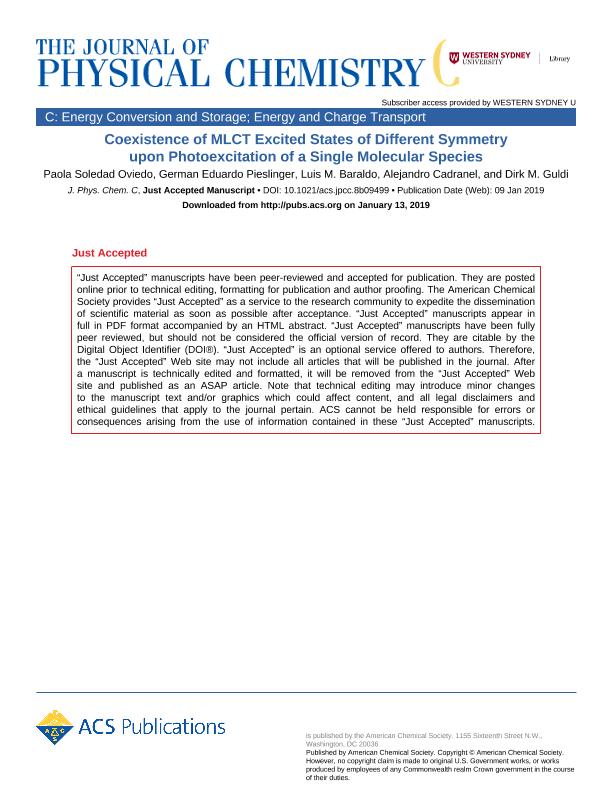Artículo
Coexistence of MLCT Excited States of Different Symmetry upon Photoexcitation of a Single Molecular Species
Oviedo, Paola Soledad ; Pieslinger, German Eduardo
; Pieslinger, German Eduardo ; Baraldo Victorica, Luis Mario
; Baraldo Victorica, Luis Mario ; Cadranel, Alejandro
; Cadranel, Alejandro ; Guldi, Dirk M.
; Guldi, Dirk M.
 ; Pieslinger, German Eduardo
; Pieslinger, German Eduardo ; Baraldo Victorica, Luis Mario
; Baraldo Victorica, Luis Mario ; Cadranel, Alejandro
; Cadranel, Alejandro ; Guldi, Dirk M.
; Guldi, Dirk M.
Fecha de publicación:
02/2019
Editorial:
American Chemical Society
Revista:
Journal of Physical Chemistry C
ISSN:
1932-7447
e-ISSN:
1932-7455
Idioma:
Inglés
Tipo de recurso:
Artículo publicado
Clasificación temática:
Resumen
Photoexcitation of [Ru(tpy)(bpy)(μ-CN)Ru(py) 4 Cl] 2+ ([RuRu] 2+ ) at 387 nm results in the population of two 3 MLCT excited states of different symmetry that coexist on the nanosecond scale. Common to both states is an excited electron in a tpy-based orbital. Their configuration differs in the position of the hole. In one excited state, 3 MLCTz, the hole sits in an orbital parallel to the intermetallic axis allowing for a strong metal-metal electronic interaction. As a result, 3 MLCTz is highly delocalized over both metal centers and shows an intense photoinduced intervalence charge transfer (PIIVCT) NIR signature. In the other excited state, 3 MLCTxy, the hole is localized in an orbital perpendicular to the intermetallic axis and hence, significant intermetallic coupling is absent. This state shows no PIIVCT in the NIR and its spectrum is very similar to the one observed for the monometallic [Ru(tpy)(bpy)(CN)] + reference. Both 3 MLCT excited states have nanosecond lifetimes. The intervening energy barrier for a hole reconfiguration between the two different 3 MLCT excited states offers the opportunity to exploit wave functions of different symmetry before either the interconversion between them or the decay to the ground state is operative.
Palabras clave:
Ruthenium
,
Photochemistry
,
Excited State
Archivos asociados
Licencia
Identificadores
Colecciones
Articulos(INQUIMAE)
Articulos de INST.D/QUIM FIS D/L MATERIALES MEDIOAMB Y ENERGIA
Articulos de INST.D/QUIM FIS D/L MATERIALES MEDIOAMB Y ENERGIA
Citación
Oviedo, Paola Soledad; Pieslinger, German Eduardo; Baraldo Victorica, Luis Mario; Cadranel, Alejandro; Guldi, Dirk M.; Coexistence of MLCT Excited States of Different Symmetry upon Photoexcitation of a Single Molecular Species; American Chemical Society; Journal of Physical Chemistry C; 123; 6; 2-2019; 3285-3291
Compartir
Altmétricas



